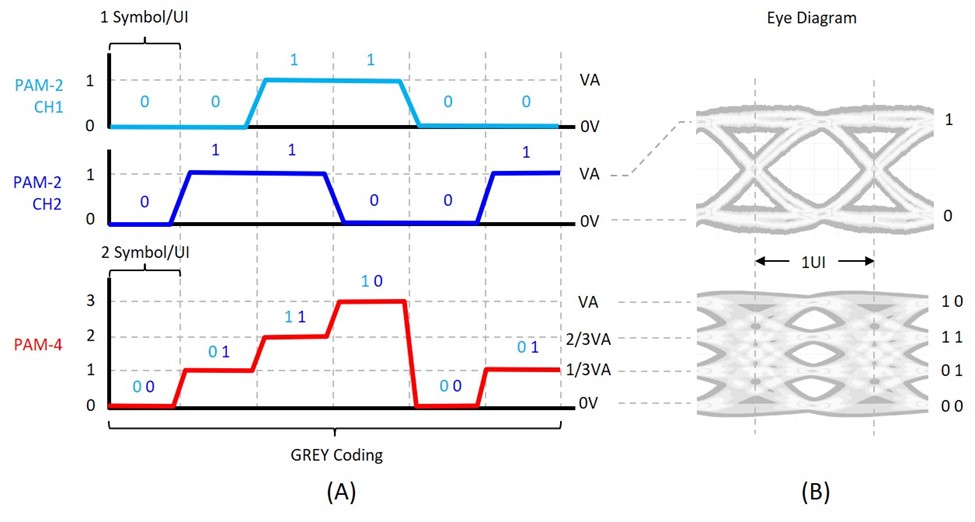To keep up with the bandwidth demands of the industry, non-return-to-zero (NRZ) signaling has been replaced by pulse amplitude modulation level-4 (PAM4) signaling. To maintain the same naming convention, NRZ signaling is now referred to as PAM2. Both terms are acceptable.
PAM2 has been widely used in various serial communication interfaces over the years due to its simplicity, robustness and lower cost to implement. The signal level remains constant during the bit interval, which helps in maintaining signal integrity with good margin. For decades it has been the workhorse for standards like PCIe and Ethernet 802.3, but as bit rates surpassed 32 Gbps, PAM4 signaling has become the standard.
PAM4 a signaling is used in high-speed data communication to effectively double the serial data rate without requiring an increase in channel bandwidth. It is commonly used in high-speed standards, such as 100G, 200G, and 400G Ethernet. It has also been adopted for PCIe Gen 6 and future Gen 7 standard. But unlike PAM2, PAM4 uses four distinct voltage levels to represent data.
 Figure 1. Comparison of (a) NRZ (PAM-2) encoding versus PAM-4 encoding and (b) respective eye diagrams.
Figure 1. Comparison of (a) NRZ (PAM-2) encoding versus PAM-4 encoding and (b) respective eye diagrams.As shown in Figure 1a, each bit time, or unit interval (UI) of a PAM2 data channel, contains one symbol, which can represent either a logic zero or a logic one. In this case the bit rate is equal to the baud rate. In PAM4 signaling, one symbol from each of the PAM-2 data channels are encoded into one bit stream using the Gray coding algorithm. The result is four voltage levels, with two symbols transmitted per UI, effectively doubling the bit rate for the same baud rate. For instance, if the bit rate is 56 Gbps, the baud rate would be 28 GBaud.
The PAM4 eye diagram in Figure 1b shows three distinct eye openings, with on-third the voltage amplitude VA, compared to the single eye opening in PAM2. These levels are binary coded as 00, 01, 10, and 11. This difference in eye opening however, leads to a 9.6 dB reduction in signal to noise ratio. This means it’s more susceptible to noise, requiring more advanced signal processing and error correction. Fortunately, forward error correction coding is used to compensate.
Through the course of my career, I have coined the phrase, “Never say never with copper. Silicon always finds a way!” The shift from NRZ (PAM2) to PAM4 signaling has enabled higher data rates while maintaining bandwidth efficiency, despite its increased complexity and noise sensitivity. As insatiable data needs continue to grow due to artificial intelligence demands, the adoption of PAM4 standard has paved the way for future PAM-level encoding schemes to address future bandwidth limitations, prolonging the life of copper interconnect.
